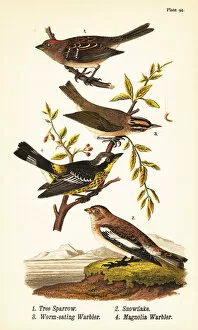Setophaga Magnolia Collection
The Magnolia Warbler, scientifically known as Setophaga magnolia, is a stunning bird species that can be found in various parts of North America
All Professionally Made to Order for Quick Shipping
The Magnolia Warbler, scientifically known as Setophaga magnolia, is a stunning bird species that can be found in various parts of North America. With its vibrant yellow plumage and distinct black streaks on its back, this warbler stands out among other avian species. One might mistake the Magnolia Warbler for an American Tree Sparrow (Spizelloides arborea) at first glance due to their similar appearance. However, upon closer inspection, one can notice the unique features that set them apart. The Magnolia Warbler's striking colors resemble a snowflake or snow bunting (Plectrophenax nivalis), adding to its allure. This small songbird also has some interesting feeding habits. Unlike most warblers that primarily feed on insects, the Magnolia Warbler has a preference for worms and larvae. Hence its scientific name Helmitheros vermivorum translates to "worm-eating warbler. " Although it may seem surprising based on its name, the Magnolia Warbler does not have any direct association with magnolias themselves but rather gets its name from French botanist Pierre Joseph Redouté who named it after his favorite flower. These beautiful birds are often spotted during migration seasons in Point Pelee National Park where they make close-up appearances for birdwatchers and nature enthusiasts alike and are known to travel far beyond their usual range as seen in Da Ponte, Corvo Azores where an immature Magnolia Warbler perched gracefully on a branch in October 2017. While sightings of these magnificent creatures are more common within the United States' borders, they continue to captivate observers with their elegance and charm wherever they go. Whether you encounter this enchanting creature while exploring Point Pelee National Park or stumble upon an immature specimen perched delicately amidst Portuguese branches like those witnessed in Da Ponte Corvo Azores – one thing is for certain, the Magnolia Warbler never fails to leave a lasting impression


